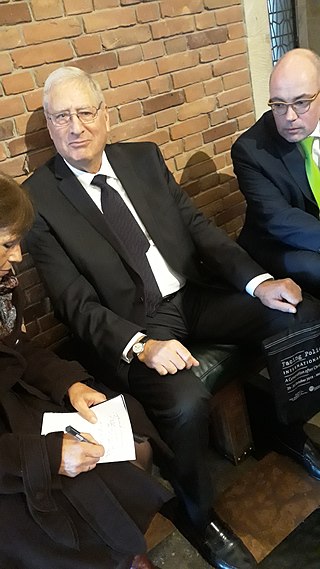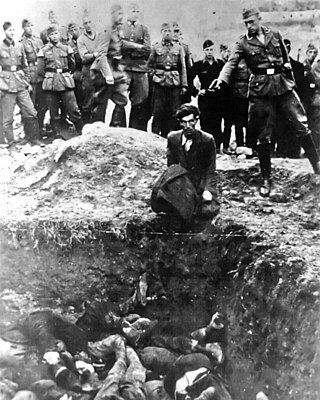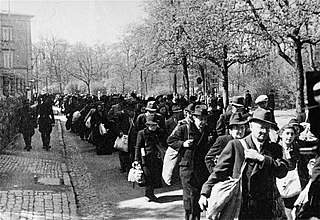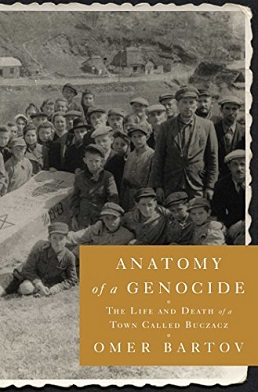"Choiceless choices" is a term coined by Lawrence Langer in his 1982 book Versions of Survival: The Holocaust and the Human Spirit, to describe the no-win situations faced by Jews during the Holocaust. [1] [2] [3] [4] [5] [6]
"Choiceless choices" is a term coined by Lawrence Langer in his 1982 book Versions of Survival: The Holocaust and the Human Spirit, to describe the no-win situations faced by Jews during the Holocaust. [1] [2] [3] [4] [5] [6]

The Final Solution or the Final Solution to the Jewish Question was a Nazi plan for the genocide of individuals they defined as Jews during World War II. The "Final Solution to the Jewish question" was the official code name for the murder of all Jews within reach, which was not restricted to the European continent. This policy of deliberate and systematic genocide starting across German-occupied Europe was formulated in procedural and geopolitical terms by Nazi leadership in January 1942 at the Wannsee Conference held near Berlin, and culminated in the Holocaust, which saw the murder of 90% of Polish Jews, and two-thirds of the Jewish population of Europe.

Nazi Germany used six extermination camps, also called death camps, or killing centers, in Central Europe, primarily Occupied Poland, during World War II to systematically murder over 2.7 million people – mostly Jews – in the Holocaust. The victims of death camps were primarily murdered by gassing, either in permanent installations constructed for this specific purpose, or by means of gas vans. The six extermination camps were Chełmno, Belzec, Sobibor, Treblinka, Majdanek and Auschwitz-Birkenau. Extermination through labour was also used at the Auschwitz and Majdanek death camps. Millions were also murdered in concentration camps, in the Aktion T4, or directly on site.
The Aryan race is a pseudoscientific historical race concept that emerged in the late-19th century to describe people who descend from the Proto-Indo-Europeans as a racial grouping. The terminology derives from the historical usage of Aryan, used by modern Indo-Iranians as an epithet of "noble". Anthropological, historical, and archaeological evidence does not support the validity of this concept.

Christopher Robert Browning is an American historian and is Professor Emeritus of History at the University of North Carolina at Chapel Hill (UNC). A specialist on the Holocaust, Browning is known for his work documenting the Final Solution, the behavior of those implementing Nazi policies, and the use of survivor testimony. He is the author of nine books, including Ordinary Men (1992) and The Origins of the Final Solution (2004).

The Kraków Ghetto was one of five major metropolitan Nazi ghettos created by Germany in the new General Government territory during the German occupation of Poland in World War II. It was established for the purpose of exploitation, terror, and persecution of local Polish Jews. The ghetto was later used as a staging area for separating the "able workers" from those to be deported to extermination camps in Operation Reinhard. The ghetto was liquidated between June 1942 and March 1943, with most of its inhabitants deported to the Belzec extermination camp as well as to Płaszów slave-labor camp, and Auschwitz concentration camp, 60 kilometres (37 mi) rail distance.
In World War II, many governments, organizations and individuals collaborated with the Axis powers, "out of conviction, desperation, or under coercion." Nationalists sometimes welcomed German or Italian troops they believed would liberate their countries from colonization. The Danish, Belgian and Vichy French governments attempted to appease and bargain with the invaders in hopes of mitigating harm to their citizens and economies.

The Holocaust in Poland was the ghettoization, robbery, deportation, and murder of Jews, simultaneously with other people groups for identical racial pretexts, in occupied Poland, organized by Nazi Germany. Three million Polish Jews were murdered, primarily at the Chelmno, Belzec, Sobibor, Treblinka, and Auschwitz II–Birkenau extermination camps, representing half of all Jews murdered during the Europe-wide Holocaust.
Choiceless awareness is posited in philosophy, psychology, and spirituality to be the state of unpremeditated, complete awareness of the present without preference, effort, or compulsion. The term was popularized in mid-20th century by Indian philosopher Jiddu Krishnamurti; the concept is a central theme in his philosophy. Similar or related concepts had been previously developed in several religious or spiritual traditions. The term, or others like it, has also been used to describe traditional and contemporary meditation practices, both secular and religious. By the early 21st century,choiceless awareness as a concept or term had appeared in a variety of fields, including neuroscience, therapy, and sociology, as well as in art. However, Krishnamurti's approach to the subject was unique, and differs from both prior and later notions.

The Holocaust in the Soviet Union was the genocide of at least 2 million Soviet Jews by Nazi Germany, Romania, and local collaborators during the German-Soviet War, part of the wider Holocaust and World War II. It may also refer to the Holocaust in the Baltic states, recently annexed by the Soviet Union before the start of Operation Barbarossa, as well as other groups murdered in the invasion.
The "double genocide theory" claims that two genocides of equal severity occurred during World War II: it alleges that the Soviet Union committed atrocities against Eastern Europeans that were equivalent in scale and nature to the Holocaust, in which approximately six million Jews were systematically murdered by Nazi Germany. The theory first gained popularity in Lithuania after the fall of the Soviet Union in 1991, particularly with regard to discussions about the Holocaust in Lithuania. A more extreme version of the theory is antisemitic and vindicates the actions of Nazi collaborators as retaliatory by accusing Jews of complicity in Soviet repression, especially in Lithuania, eastern Poland, and northern Romania. Scholars have criticized the double genocide theory as a form of Holocaust trivialization.

The Last Jew in Vinnitsa is a photograph taken during the Holocaust in Ukraine showing an unknown Jewish man—probably on 28 July 1941 in Berdychiv (Berditschew) and not Vinnitsya—about to be shot dead by a member of Einsatzgruppe D, a mobile death squad of the Nazi SS. The victim is kneeling beside a mass grave already containing bodies; behind, a group of SS and Reich Labour Service men watch.

Secret City: The Hidden Jews of Warsaw 1940–1945 is a 2002 book by Gunnar S. Paulsson. It was translated to Polish in 2008. Secret City is a social history of the Jews who escaped from the Warsaw Ghetto and tried to survive, living illegally "on the Aryan side". The book has received mostly favourable reviews, with several historians calling it "significant", "a milestone" and “riveting study".
Pechora was a concentration camp operated by Romania during World War II in the village of Pechora, now in Ukraine. The concentration camp was established on the gated grounds of what had once been a private estate of the Polish noble Potocki family on the banks of the Southern Bug river, which had been converted into a sanatorium for tuberculosis patients after the Russian revolution.

The question of how much Germans knew about the Holocaust whilst it was being executed is a matter of debate by historians. In Nazi Germany, it was an open secret among the population by 1943, Peter Longerich argues, but some authors place it even earlier. After the war, many Germans claimed that they were ignorant of the crimes perpetrated by the Nazi regime, a claim associated with the stereotypical phrase "Davon haben wir nichts gewusst".
Evgeny Finkel or Eugene Finkel is a political scientist and historian at Johns Hopkins University who studies political violence, genocide, East European and Israeli politics, and Holocaust studies. In April 2022, Finkel claimed that after the initial phase of the 2022 Russian invasion of Ukraine was resisted by Ukrainian armed forces, the aims of the invasion evolved, and the combined evidence of widespread war crimes, including the Bucha massacre, together with genocidal intent, as illustrated by the essay What Russia should do with Ukraine published in RIA Novosti, established that genocide was taking place.
The International Conference on the Holocaust and Genocide was the first major conference in the field of genocide studies, held in Tel Aviv on 20–24 June 1982. It was organized by Israel Charny, Elie Wiesel, Shamai Davidson, and their Institute on the Holocaust and Genocide, founded in 1979. The conference's objective was to further the understanding and prevention of all genocides; it marked the shift from viewing genocide as an irrational phenomenon to one that could be studied and understood.

Anatomy of a Genocide: The Life and Death of a Town called Buczacz is a 2018 book by historian Omer Bartov exploring ethnic relations between Poles, Ukrainians, and Jews in the town of Buczacz with a focus on the Holocaust.

The Holocaust in Greece was the mass murder of Greek Jews, mostly as a result of their deportation to Auschwitz concentration camp, during World War II. By 1945, between 82 and 92 percent of Greek Jews had been murdered, one of the highest proportions in Europe.
This is a list of selected papers or books about the Holocaust in Greece.